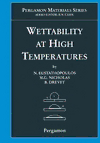Download Wettability at High Temperatures PDF Free - Full Version
Download Wettability at High Temperatures by Eustathopoulos N., Nicholas M.G., Drevet B. in PDF format completely FREE. No registration required, no payment needed. Get instant access to this valuable resource on PDFdrive.to!
About Wettability at High Temperatures
PERGAMON MATERIALS SERIES VOLUME 3The purpose of this book is to bring together current scientific understanding of wetting behaviour that has been gained from theoretical models and quantitative experimental observations. The materials considered are liquid metals or inorganic glasses in contact with solid metals or ceramics at temperatures of 200-2000oC.Wetting has been a significant scientific concern for the last two centuries and reference will be made to classical work by nineteenth century scientists such as Dupré, Laplace and Young that was validated by observations of the behaviour of chemically inert ambient temperature systems.In attempting to achieve the aims of the book, the text has been divided into ten Chapters that can be grouped into four stages of presentation. The first stage comprises two Chapters that review established and newly developed models for their relevance to wetting behaviour at high temperatures, including recent models that encompass the role of chemical reactions at the solid/liquid interfaces. Attention is paid both to equilibrium wetting behaviour (Chapter 1) and to the factors that control the approach to equilibrium (Chapter 2). Then follow Chapters concerned with experimental techniques for scientific measurement of the extent of wetting (Chapter 3) and with the surface energy data for both metals and non-metals that are essential for quantitative interpretation of wetting behaviour (Chapter 4). Descriptions of experimentally determined and quantified wetting behaviour are presented and interpreted in the third part comprising five Chapters dealing with the characteristics of metal/metal, metal/oxide, metal/non-oxide, metal/carbon and molten glass/solid systems. The book concludes with a Chapter commenting on the role of wetting behaviour in joining similar and dissimilar materials by liquid route techniques.
Detailed Information
| Author: | Eustathopoulos N., Nicholas M.G., Drevet B. |
|---|---|
| Publication Year: | 1999 |
| Pages: | 439 |
| Language: | English |
| File Size: | 16.642 |
| Format: | |
| Price: | FREE |
Safe & Secure Download - No registration required
Why Choose PDFdrive for Your Free Wettability at High Temperatures Download?
- 100% Free: No hidden fees or subscriptions required for one book every day.
- No Registration: Immediate access is available without creating accounts for one book every day.
- Safe and Secure: Clean downloads without malware or viruses
- Multiple Formats: PDF, MOBI, Mpub,... optimized for all devices
- Educational Resource: Supporting knowledge sharing and learning
Frequently Asked Questions
Is it really free to download Wettability at High Temperatures PDF?
Yes, on https://PDFdrive.to you can download Wettability at High Temperatures by Eustathopoulos N., Nicholas M.G., Drevet B. completely free. We don't require any payment, subscription, or registration to access this PDF file. For 3 books every day.
How can I read Wettability at High Temperatures on my mobile device?
After downloading Wettability at High Temperatures PDF, you can open it with any PDF reader app on your phone or tablet. We recommend using Adobe Acrobat Reader, Apple Books, or Google Play Books for the best reading experience.
Is this the full version of Wettability at High Temperatures?
Yes, this is the complete PDF version of Wettability at High Temperatures by Eustathopoulos N., Nicholas M.G., Drevet B.. You will be able to read the entire content as in the printed version without missing any pages.
Is it legal to download Wettability at High Temperatures PDF for free?
https://PDFdrive.to provides links to free educational resources available online. We do not store any files on our servers. Please be aware of copyright laws in your country before downloading.
The materials shared are intended for research, educational, and personal use in accordance with fair use principles.

